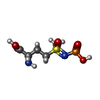[English] 日本語
 Yorodumi
Yorodumi- PDB-7ten: Crystal structure of the Listeria monocytogenes GS-Met-Sox-P- ADP... -
+ Open data
Open data
- Basic information
Basic information
| Entry | Database: PDB / ID: 7ten | ||||||
|---|---|---|---|---|---|---|---|
| Title | Crystal structure of the Listeria monocytogenes GS-Met-Sox-P- ADP complex to 3.5 Angstrom | ||||||
 Components Components | Glutamine synthetase | ||||||
 Keywords Keywords | LIGASE/INHIBITOR / glutamate ammonium ligase / GlnR / GS /  glutamine synthetase / Met-Sox / glutamine synthetase / Met-Sox /  transition state / transition state /  LIGASE / LIGASE-INHIBITOR complex LIGASE / LIGASE-INHIBITOR complex | ||||||
| Function / homology |  Function and homology information Function and homology information glutamine synthetase / glutamine biosynthetic process / glutamine synthetase / glutamine biosynthetic process /  glutamine synthetase activity / glutamine synthetase activity /  ATP binding / ATP binding /  metal ion binding / metal ion binding /  cytoplasm cytoplasmSimilarity search - Function | ||||||
| Biological species |   Listeria monocytogenes (bacteria) Listeria monocytogenes (bacteria) | ||||||
| Method |  X-RAY DIFFRACTION / X-RAY DIFFRACTION /  SYNCHROTRON / SYNCHROTRON /  MOLECULAR REPLACEMENT / MOLECULAR REPLACEMENT /  molecular replacement / Resolution: 3.5 Å molecular replacement / Resolution: 3.5 Å | ||||||
 Authors Authors | Schumacher, M.A. | ||||||
| Funding support |  United States, 1items United States, 1items
| ||||||
 Citation Citation |  Journal: Nat Commun / Year: 2022 Journal: Nat Commun / Year: 2022Title: Molecular dissection of the glutamine synthetase-GlnR nitrogen regulatory circuitry in Gram-positive bacteria. Authors: Brady A Travis / Jared V Peck / Raul Salinas / Brandon Dopkins / Nicholas Lent / Viet D Nguyen / Mario J Borgnia / Richard G Brennan / Maria A Schumacher /  Abstract: How bacteria sense and respond to nitrogen levels are central questions in microbial physiology. In Gram-positive bacteria, nitrogen homeostasis is controlled by an operon encoding glutamine ...How bacteria sense and respond to nitrogen levels are central questions in microbial physiology. In Gram-positive bacteria, nitrogen homeostasis is controlled by an operon encoding glutamine synthetase (GS), a dodecameric machine that assimilates ammonium into glutamine, and the GlnR repressor. GlnR detects nitrogen excess indirectly by binding glutamine-feedback-inhibited-GS (FBI-GS), which activates its transcription-repression function. The molecular mechanisms behind this regulatory circuitry, however, are unknown. Here we describe biochemical and structural analyses of GS and FBI-GS-GlnR complexes from pathogenic and non-pathogenic Gram-positive bacteria. The structures show FBI-GS binds the GlnR C-terminal domain within its active-site cavity, juxtaposing two GlnR monomers to form a DNA-binding-competent GlnR dimer. The FBI-GS-GlnR interaction stabilizes the inactive GS conformation. Strikingly, this interaction also favors a remarkable dodecamer to tetradecamer transition in some GS, breaking the paradigm that all bacterial GS are dodecamers. These data thus unveil unique structural mechanisms of transcription and enzymatic regulation. | ||||||
| History |
|
- Structure visualization
Structure visualization
| Structure viewer | Molecule:  Molmil Molmil Jmol/JSmol Jmol/JSmol |
|---|
- Downloads & links
Downloads & links
- Download
Download
| PDBx/mmCIF format |  7ten.cif.gz 7ten.cif.gz | 2.1 MB | Display |  PDBx/mmCIF format PDBx/mmCIF format |
|---|---|---|---|---|
| PDB format |  pdb7ten.ent.gz pdb7ten.ent.gz | Display |  PDB format PDB format | |
| PDBx/mmJSON format |  7ten.json.gz 7ten.json.gz | Tree view |  PDBx/mmJSON format PDBx/mmJSON format | |
| Others |  Other downloads Other downloads |
-Validation report
| Arichive directory |  https://data.pdbj.org/pub/pdb/validation_reports/te/7ten https://data.pdbj.org/pub/pdb/validation_reports/te/7ten ftp://data.pdbj.org/pub/pdb/validation_reports/te/7ten ftp://data.pdbj.org/pub/pdb/validation_reports/te/7ten | HTTPS FTP |
|---|
-Related structure data
| Related structure data | 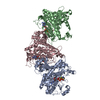 7tdpSC  7tdvC  7teaC 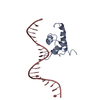 7tecC 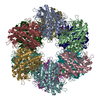 7tf6C  7tf7C 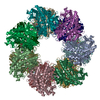 7tf9C 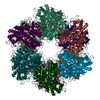 7tfaC 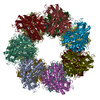 7tfbC 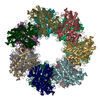 7tfcC  7tfdC  7tfeC S: Starting model for refinement C: citing same article ( |
|---|---|
| Similar structure data | Similarity search - Function & homology  F&H Search F&H Search |
- Links
Links
- Assembly
Assembly
| Deposited unit | 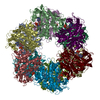
| ||||||||
|---|---|---|---|---|---|---|---|---|---|
| 1 |
| ||||||||
| Unit cell |
|
- Components
Components
| #1: Protein |  Mass: 50874.691 Da / Num. of mol.: 12 Source method: isolated from a genetically manipulated source Source: (gene. exp.)   Listeria monocytogenes (bacteria) Listeria monocytogenes (bacteria)Gene: glnA, BW273_06565, CW834_10155, E3W32_09805, E5H26_02065, FL871_07615, GF092_00575, GIG92_01785, GIH49_01255, HF764_002412 Production host:   Escherichia coli (E. coli) / References: UniProt: A0A5D5GA79, Escherichia coli (E. coli) / References: UniProt: A0A5D5GA79,  glutamine synthetase glutamine synthetase#2: Chemical | ChemComp-ADP /  Adenosine diphosphate Adenosine diphosphate#3: Chemical | ChemComp-P3S / Has ligand of interest | Y | |
|---|
-Experimental details
-Experiment
| Experiment | Method:  X-RAY DIFFRACTION / Number of used crystals: 1 X-RAY DIFFRACTION / Number of used crystals: 1 |
|---|
- Sample preparation
Sample preparation
| Crystal | Density Matthews: 2.81 Å3/Da / Density % sol: 56.15 % |
|---|---|
Crystal grow | Temperature: 298 K / Method: vapor diffusion, hanging drop Details: 15% PEG 4000, 40 mM potassium phosphate dibasic pH 7.5, 20% glycerol |
-Data collection
| Diffraction | Mean temperature: 100 K / Serial crystal experiment: N |
|---|---|
| Diffraction source | Source:  SYNCHROTRON / Site: SYNCHROTRON / Site:  ALS ALS  / Beamline: 5.0.2 / Wavelength: 1.01 Å / Beamline: 5.0.2 / Wavelength: 1.01 Å |
| Detector | Type: DECTRIS PILATUS 6M / Detector: PIXEL / Date: Mar 12, 2021 |
| Radiation | Protocol: SINGLE WAVELENGTH / Monochromatic (M) / Laue (L): M / Scattering type: x-ray |
| Radiation wavelength | Wavelength : 1.01 Å / Relative weight: 1 : 1.01 Å / Relative weight: 1 |
| Reflection | Resolution: 3.5→63.88 Å / Num. obs: 62204 / % possible obs: 74.7 % / Redundancy: 3.1 % / CC1/2: 0.995 / Rpim(I) all: 0.13 / Rsym value: 0.184 / Net I/σ(I): 4.8 |
| Reflection shell | Resolution: 3.5→3.62 Å / Mean I/σ(I) obs: 1.2 / Num. unique obs: 6451 / CC1/2: 0.323 / Rpim(I) all: 0.966 / Rsym value: 1.15 |
-Phasing
Phasing | Method:  molecular replacement molecular replacement |
|---|
- Processing
Processing
| Software |
| ||||||||||||||||||||||||||||||||||||||||||||||||||||||||||||||||||||||||||||||||||||||||||||||||||||||||||||||||||||||||||||||||||||||||||||||||||||||
|---|---|---|---|---|---|---|---|---|---|---|---|---|---|---|---|---|---|---|---|---|---|---|---|---|---|---|---|---|---|---|---|---|---|---|---|---|---|---|---|---|---|---|---|---|---|---|---|---|---|---|---|---|---|---|---|---|---|---|---|---|---|---|---|---|---|---|---|---|---|---|---|---|---|---|---|---|---|---|---|---|---|---|---|---|---|---|---|---|---|---|---|---|---|---|---|---|---|---|---|---|---|---|---|---|---|---|---|---|---|---|---|---|---|---|---|---|---|---|---|---|---|---|---|---|---|---|---|---|---|---|---|---|---|---|---|---|---|---|---|---|---|---|---|---|---|---|---|---|---|---|---|
| Refinement | Method to determine structure : :  MOLECULAR REPLACEMENT MOLECULAR REPLACEMENTStarting model: 7TDP Resolution: 3.5→63.88 Å / SU ML: 0.55 / Cross valid method: THROUGHOUT / σ(F): 1.96 / Phase error: 30.51 / Stereochemistry target values: ML
| ||||||||||||||||||||||||||||||||||||||||||||||||||||||||||||||||||||||||||||||||||||||||||||||||||||||||||||||||||||||||||||||||||||||||||||||||||||||
| Solvent computation | Shrinkage radii: 0.9 Å / VDW probe radii: 1.11 Å / Solvent model: FLAT BULK SOLVENT MODEL | ||||||||||||||||||||||||||||||||||||||||||||||||||||||||||||||||||||||||||||||||||||||||||||||||||||||||||||||||||||||||||||||||||||||||||||||||||||||
| Displacement parameters | Biso max: 283.39 Å2 / Biso mean: 113.2813 Å2 / Biso min: 42.11 Å2 | ||||||||||||||||||||||||||||||||||||||||||||||||||||||||||||||||||||||||||||||||||||||||||||||||||||||||||||||||||||||||||||||||||||||||||||||||||||||
| Refinement step | Cycle: final / Resolution: 3.5→63.88 Å
| ||||||||||||||||||||||||||||||||||||||||||||||||||||||||||||||||||||||||||||||||||||||||||||||||||||||||||||||||||||||||||||||||||||||||||||||||||||||
| Refine LS restraints |
| ||||||||||||||||||||||||||||||||||||||||||||||||||||||||||||||||||||||||||||||||||||||||||||||||||||||||||||||||||||||||||||||||||||||||||||||||||||||
| LS refinement shell | Refine-ID: X-RAY DIFFRACTION / Rfactor Rfree error: 0 / Total num. of bins used: 14
| ||||||||||||||||||||||||||||||||||||||||||||||||||||||||||||||||||||||||||||||||||||||||||||||||||||||||||||||||||||||||||||||||||||||||||||||||||||||
| Refinement TLS params. | Method: refined / Origin x: 10.124 Å / Origin y: -44.8282 Å / Origin z: 0.4931 Å
| ||||||||||||||||||||||||||||||||||||||||||||||||||||||||||||||||||||||||||||||||||||||||||||||||||||||||||||||||||||||||||||||||||||||||||||||||||||||
| Refinement TLS group |
|
 Movie
Movie Controller
Controller










 PDBj
PDBj


